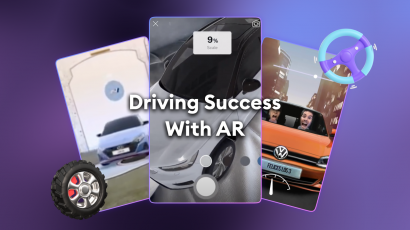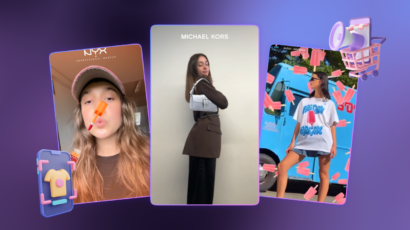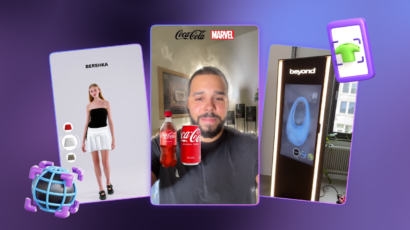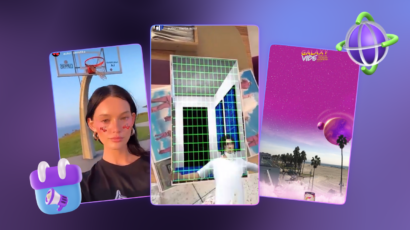The automotive sector is facing transformation due to Augmented Reality (AR) technology, offering unique and innovative methods of promoting products to consumers. Customers may engage with virtual car models, explore their features, and customize them in ways that feel more immersive than traditional advertising thanks to AR marketing. By enabling customers to see and feel things in a more memorable and compelling way, AR marketing also enhances product recognition and favourability, ultimately boosting sales and revenue for automotive companies.
From manufacturing to maintenance, the automotive sector has several choices to employ AR in a variety of ways to promote and empower brands at their absolute best. Of course, it also has a plethora of advantages in marketing. Marketers are already utilizing AR to introduce campaigns with features that raise engagement and brand recognition.
According to Fortune Business Insights Research, the global market for AR in the automotive industry has grown significantly over the past few years and is anticipated to increase by 18.1% CAGR from USD 4.51 billion in 2021 to USD 14.44 billion in 2028.
Numerous issues facing the automotive industry can be solved with AR marketing. Differentiating from rivals and distinguishing out in a competitive market are two big challenges. AR marketing can offer a distinctive and entertaining approach to exhibiting products and set yourself apart from competitors. A further issue is enhancing the consumer experience, which AR marketing can handle this by providing a more individualized and interactive purchasing experience that enables customers to explore products in a more engaging way.
Moreover, by providing a more cutting-edge and inventive manner to promote goods and appealing to younger, tech-savvy consumers who may be more willing to interact with AR experiences, AR marketing can draw in new audiences.
With AR, customers can make well-informed choices and feel secure about their purchases. Such interactions with a company can strengthen consumer loyalty and create a lasting impression.
Increasing ad recall with world AR product visualizations
Using World AR for product visualization, Hyundai was able to improve brand KPIs and lead to a 12.5-point boost in standard ad recall by adding AR filters to their standard Facebook and Instagram video commercials.
The AR advertisements also increased product awareness by 8.4 points and product favorability by 5.9 points, showing that AR may not only boost engagement but also generate revenue. This success can be due to the distinctive and immersive experience that AR offers, enabling users to interact with virtual models of vehicles and have a more profound and lasting experience. Hyundai’s usage of AR technology in its marketing strategy demonstrates the potential for other automakers to employ augmented reality to set themselves apart from rivals and enhance their overall marketing initiatives.
Exceed engagement norms with increased save rates and earned reach with Face Filters
One of the best examples of how AR technology can be utilized to broaden engagement and reach among a younger demographic is Volkswagen’s usage of social AR and face filters on Snapchat. Volkswagen was able to go above and above engagement expectations and achieve a 7.4% save rate and 7% earned reach by creating an entertaining and interactive Lens experience that allowed consumers to share the screen with a friend and have a virtual ride in a VW Polo.
This success can be ascribed to the experience’s ability to be customized and shared, which allowed users to not only interact with the VW brand in a distinctive way but also to tell their friends and followers about it. Volkswagen’s use of social AR and face filters serves as an example of the potential for automakers to leverage AR technology to attract younger, tech-savvy consumers and boost brand awareness through entertaining and shareable experiences.
Generate product awareness with interactive product personalization
Volvo was able to raise awareness of its new electric SUV model and witnessed a 6.7-point jump in awareness by utilizing AR technology to generate interactive product personalization. The effective usage of AR by Volvo in their Facebook advertising campaign shows how the technology can be applied to raise brand recognition and boost engagement.The AR advertisements also led to a 14.2-point improvement in ad recall, showing that AR technology may boost brand awareness and memory in addition to engagement.
The AR experience gave customers a true-to-scale view of the car, giving the product a more realistic and engaging visualization. As a consequence, 43,249 users of the AR effect and 282,000 previously uninformed individuals learned about the XC40 Recharge.
Volvo exemplifies the potential of utilizing AR technology in automotive companies’ marketing campaigns to increase consumer awareness of their products and offers captivating, memorable experiences.
Supercharging Brand Awareness and Philanthropy with AR Games
The Super Bowl ad campaign of Kia using AR technology is a great illustration of how automakers can use augmented reality to promote their brands, foster brand loyalty, and support charitable causes. During the Super Bowl, Kia and 14Four debuted Robo Dog to millions of viewers. The game’s real-time character responds dynamically to human input, forging an emotional connection and a highly engaging experience. It was created with innovation and user engagement in mind.
Along with using a selfie lens and linking to the Petfinder Foundation website, Kia employed social media promotion and charity to further the campaign’s goals of helping local animals in need and raising awareness of it on online platforms.Overall, Kia’s usage of AR technology in its Super Bowl ad campaign helped the firm create its unique augmented reality experience, raising brand awareness, charity, and philanthropy.
Revving Up Sales: AR Marketing is Driving the Automotive Industry Forward
Due to its potential to improve customer experiences and increase sales, AR marketing has grown in significance for the automobile sector. Utilizing AR technology, auto marketers can provide consumers with fun and interactive experiences where they can envision and customize vehicles in real-time, simplifying and enhancing the buying experience. Given the enormous potential of aAR marketing, it has emerged as a vital tool for automakers to increase customer engagement and satisfaction, operational effectiveness, and market competitiveness. AR is redefining how we connect with companies, goods, and services. With AR capabilities, marketers are no longer constrained by the limits of their imagination when it comes to developing campaigns that will resonate with their audience.
Take a deeper look and join us as we explore the world of AR. Set up a brief conversation as soon as possible to get an AR marketing strategy tailored to your company’s needs.








